Finding the right hearing aid involves choosing the style that fits your lifestyle needs, level of hearing loss, and personal preferences. With various types of hearing aids on the market, it can be challenging to figure out what’s right for you.
This article aims to make the process easier by covering the six main hearing aid types, how they work, and whether they may be your perfect match.
Key Takeaways
- There are six main hearing aid styles divided into behind-the-ear and in-the-ear devices.
- Hearing aids can be analog or digital, although the latter is the most commonly sold.
- Consider your lifestyle, budget, level of hearing loss, and willingness to maintain the devices to find the best hearing aid for you.
- BTE hearing aids come in an earmold or receiver in the ear version.
- ITE hearing aids are either completely-in-canal, in-the-canal, or invisible-in-the-canal
What Are the Different Types of Hearing Aids?
The most common hearing aid styles fall into two categories; behind the ear (BTE) and in the ear (ITE) hearing aids.
Behind the Ear Hearing Aids (BTE)
The body of a BTE hearing aid sits behind the ear. It is usually held in place by hooking over the top part of your ear, via which a thin plastic tube connected to an earmold or receiver fits into your ear canal.
BTE hearing aids are suitable for mild to severe or profound hearing loss, and the design of the receiver allows ambient sound to pass into the ear naturally, improving the overall sound quality.
In the Ear Hearing Aids (ITE)
ITE hearing aids fit entirely inside your ear, typically with only a part of it visible in your outer ear. In the ear hearing aids usually come with directional microphones and can treat mild to severe hearing loss, although the devices are often more prone to damage from ear wax.
Types of Hearing Aids Pictures
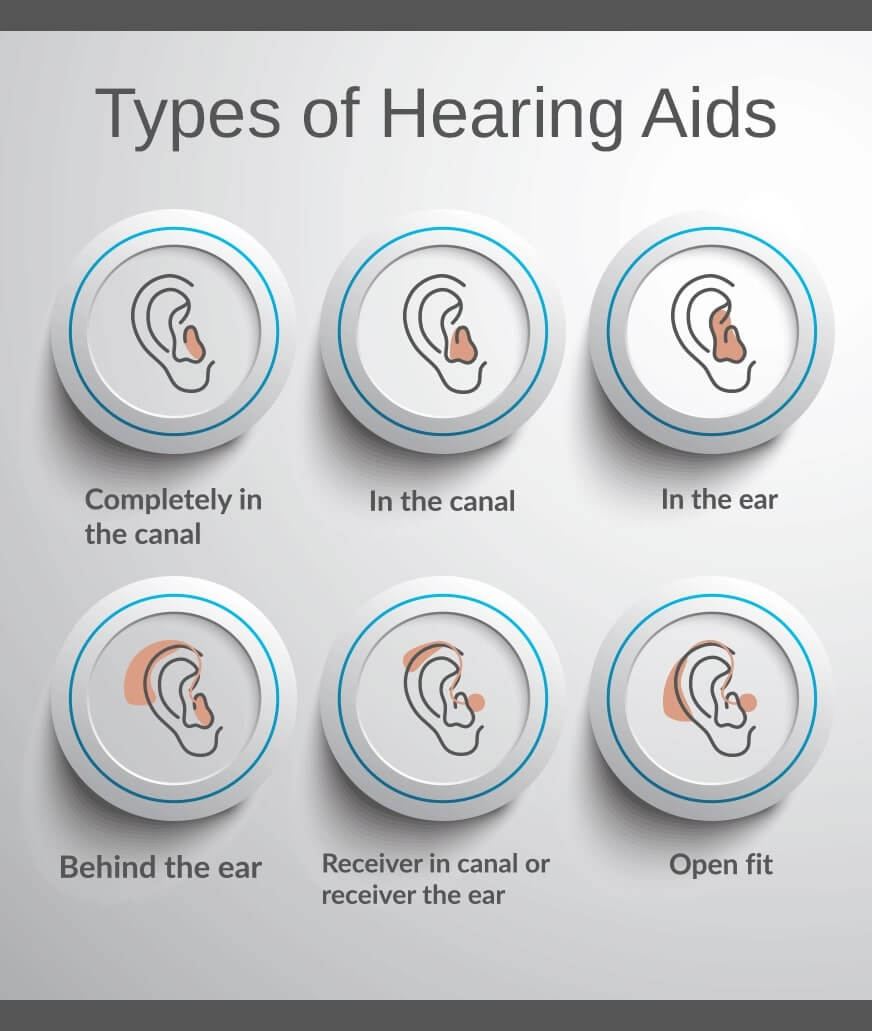
Digital vs. Analog Hearing Aids
Hearing aids can also be divided into two categories based on their working mechanism.
To understand the difference between a digital and analog hearing aid, you should know how hearing aids work.
Most hearing aids work in three steps:
- The device’s microphone receives sound vibrations.
- The device’s amplifier makes the sound louder.
- The device’s speaker emits the sound into your ear.
For more information on how hearing aids work, check out our article on hearing aid parts.
The difference between analog and digital hearing aids stems from the way sound is processed.
Analog hearing aids only make sound waves louder and amplify all the microphone sounds, including background noise.
Digital hearing aids convert sound waves into electrical signals, which can be sampled and processed to produce an exact duplicate of the sounds you need to hear. Often digital hearing aids produce much clearer audio, while analog hearing aids are cheaper. Despite this, most hearing aids on the market work on a digital system.
Different Styles of Hearing Aids – Behind the Ear
Each main category of hearing aids also has several subgroups of hearing aid styles. Behind the ear hearing aids typically come in two models; with an earmold or with the receiver in the canal.
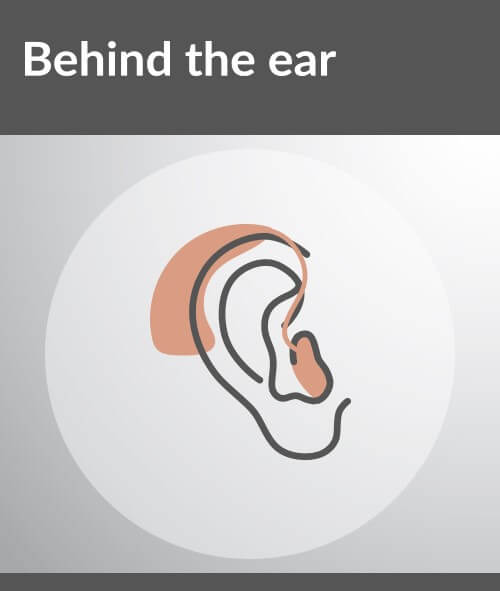
With Earmold
These behind-the-ear style hearing aids come with a silicone or plastic ear mold connected to the tube attached to the device’s body. Earmolds are usually custom-fit to match the shape of your ear canal and provide comfort alongside excellent sound transmission.
BTE hearing aids with earmolds are better at delivering sound and are suitable for people with low to high-frequency hearing loss.
Pros:
- Provide great sound quality
- Suitable for people with low-frequency hearing loss
- Comfortable fit and design
- Reduces the occurrence of feedback loops
Cons:
- It may be difficult to get used to
- Earmolds may need to be adjusted as your ear shape changes
- May cause earwax buildup
- If not correctly fitted, it can make your voice sound too loud
Receiver in the Ear (RITE)

Also known as receiver in canal (RIC) devices, these hearing aids have their body fitted behind the ear with an insertable dome containing the speaker placed within the ear canal.
RITE devices are usually less noticeable than regular earmold versions but are also prone to causing earwax buildup.
Pros:
- Less visible than the earmold version
- It can be repaired if the speaker is damaged
- Excellent sound quality while allowing the passage of ambient sound into the ear
Cons:
- May result in earwax buildup
- Speaker may be damaged by inner ear moisture
Different Styles of Hearing Aids – In the Ear
An alternative to behind-the-ear hearing aid styles is those that fall into the in-the-ear category.
In the ear (ITE), hearing aids can fit in the canal or slightly protrude from the outer ear and are less noticeable than behind the ear versions.
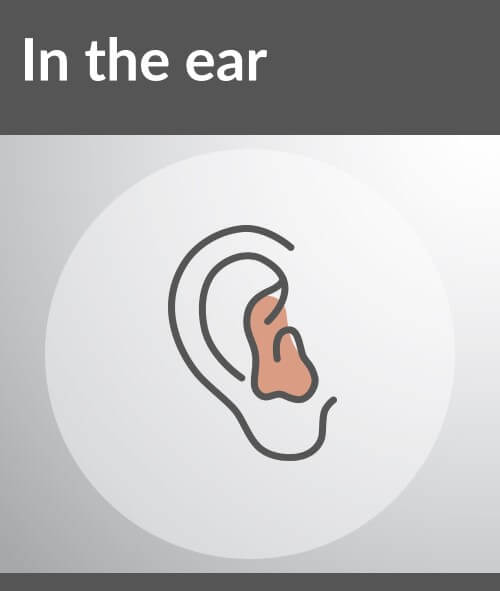
Low Profile Hearing Aids
Low profile in the ear (ITE) hearing aids usually fill all or part of your outer ear while completely covering the entrance to your ear canal. The devices are typically available in a range of beige or brown shades to match the wearer’s skin tone.
Pros:
- The larger size means more functions and longer battery life
- Easy to insert and remove
- Can use directional microphones
Cons:
- More noticeable than other ITE styles
- It can feel like it’s blocking your ear
In the Canal (ITC)
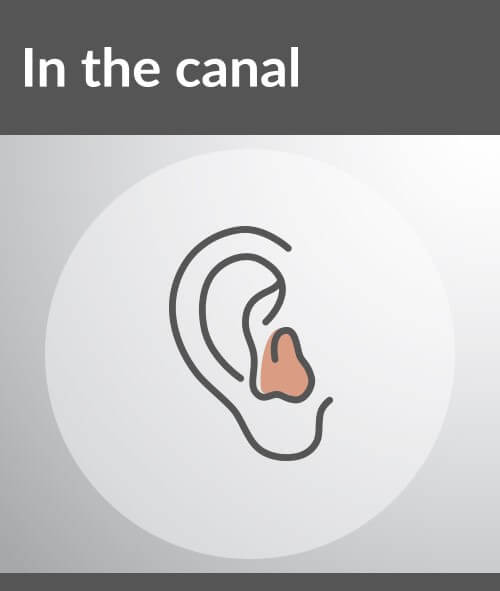
In the ear canal (ITC) hearing aids are true to their name and sit somewhat protruding into your ear canal, with part of it visible in your outer ear.
ITC hearing aids are suitable for treating mild to moderate hearing loss and often come with directional microphones to improve sound clarity and quality. In-the-canal aids are also less noticeable than low-profile or behind-the-ear hearing aids.
Pros:
- Discreet and relatively unnoticeable
- It can still be controlled manually
- Better battery life than many other ITC devices
Cons:
- Aren’t suitable for profound hearing loss
- Can cause wax or moisture buildup
Completely In Canal (CIC)
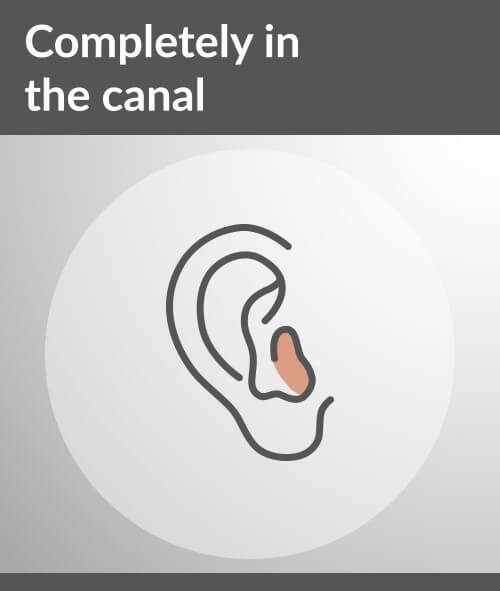
Completely in the canal hearing aids are one of the most discreet hearing aid styles available. The entire device fits in the ear canal, making it very difficult to spot.
CIC devices are tiny and can treat mild to moderately severe hearing loss while maintaining a high-quality sound standard.
Pros:
- It can be used to treat mild to moderately severe hearing loss
- Less noticeable than other ITC devices
- Less prone to wind interference or whistling
Cons:
- Smaller batteries to fit the device’s size means shorter battery life
- Can cause wax and moisture buildup
Invisible In Canal (IIC)
Invisible-in-canal hearing aids are even smaller than the completely-in-the-canal models. They also fit deeper in the ear canal.
A smartphone app usually controls IIC hearing aids, and you cannot adjust their volume or noise reduction levels without it. However, the devices do not sacrifice sound quality as their position within the ear improves overall sound clarity and reduces possible interference.
Pros:
- Completely invisible, most people won’t even realize someone is wearing them unless told
- Location in the ear canal reduces interference from using your phone or whistling due to the wind
- The location of the device also ensures excellent sound quality overall
Cons:
- Battery life may be lacking due to size
- Can cause wax or moisture buildup
- May only be suitable for mild to moderate hearing loss
Types of Hearing Aids and Costs
Hearing aid prices vary by style and type. Sample prices for each model are listed below:
- BTE hearing aid: $799.99, MDHearingAid AIR
- ITE in-the-canal: $2,274.00, Phonak Virto Marvel
- ITE invisible-in-canal: $1,500.00, Eargo MAX
How To Choose a Hearing Aid
Choosing the right hearing aids can significantly help ease your hearing loss symptoms, although they will never restore normal hearing entirely.
Some critical factors to consider when choosing a hearing aid include:
- When to get a hearing aid
- Type and severity of hearing loss
- Your lifestyle
- Hearing aid maintenance
When Should You Get a Hearing Aid?
If you suspect you are suffering from hearing loss, you should either take an online hearing test or visit an audiologist.
Who do you think is more likely to report trouble hearing without a hearing aid?
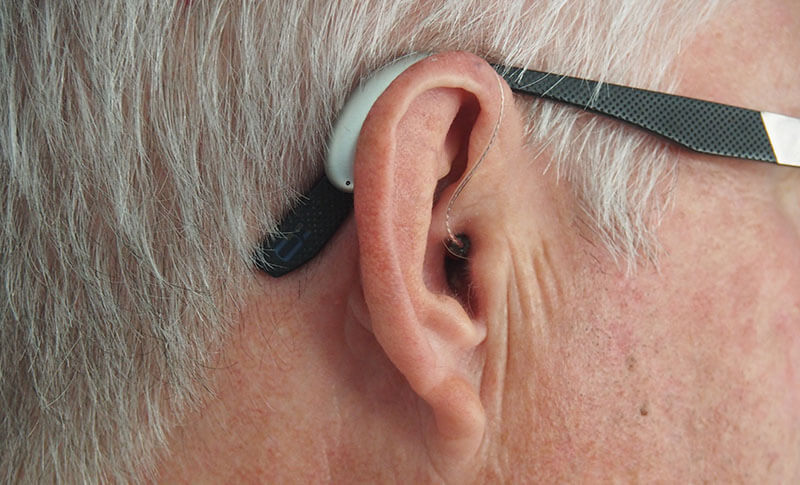
Without visiting an audiologist, your options may be limited to over-the-counter hearing aids. However, these devices can be just as high quality as those prescribed by a medical professional.
Once you have confirmed you are experiencing hearing loss, you can choose one of various pathways to order or purchase a hearing aid.
Type and Severity of Hearing Loss
Some hearing aid styles and brands may not be suitable if you suffer from severe, profound, or low-frequency hearing loss.
You may also need to assess whether you are experiencing hearing loss in one or both ears and subsequently need one or two hearing aids.
According to your hearing ability, the following hearing aid styles may be recommended:
- Low-frequency hearing loss: BTE with an earmold
- Mild to moderate hearing loss: ITC, CIC, and IIC hearing aids
- Severe hearing loss: BTE receiver-in-ear or ITE in-canal hearing aids
- Profound hearing loss: BTE devices
Who do you think is more prone to report severe hearing loss?
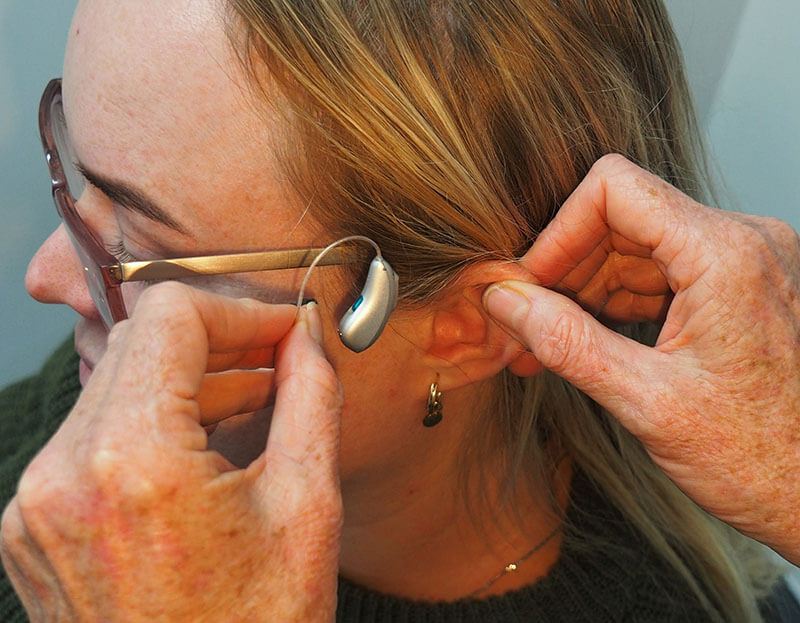
Consider Your Lifestyle
If you want to wear hearing aids to improve your listening abilities, it is crucial to consider your lifestyle when choosing which style to purchase.
If you spend much of your time on electronics, you may wish to opt for a hearing aid style big enough to facilitate Bluetooth connectivity and receive direct audio input.
If you regularly work in noisy listening environments, choosing a BTE device with an earmold or a low-profile ITE device may help reduce background noise and interference.
If the cost of hearing aids is important to you, you may want to check if your insurance benefits cover hearing aids from a specific manufacturer. Otherwise, purchasing used or refurbished aids may also be a suitable option.
Hearing Aid Maintenance
Some hearing aids, like the ITE models, are more likely to have earwax and moisture buildup. If you don’t like the idea of regularly maintaining your hearing aids, it may be better to opt for a behind-the-ear model.
Consider the warranty provided by whichever brand of hearing aid you wish to buy.
If you want to know more about how to clean hearing aids, check out our detailed article on the topic.
FAQ
Let’s answer some of the commonly asked questions.
How Many Types of Hearing Aid Are There?
There are six main hearing aid types divided into two categories; behind the ear and in the ear.
However, many hearing aid manufacturers create specialized models that typically only differ slightly from these six options.
What Is the Best Inexpensive Hearing Aid?
MDHearingAid manufactures the most affordable yet high-quality hearing aids. Their devices are all behind-the-ear, receiver in canal styles but provide excellent sound clarity and noise reduction at a fraction of the price of other similar devices.
For a complete list of affordable brands, check out our article on cheap hearing aids.
What Is the Most Comfortable Hearing Aid?
The most comfortable hearing aids are typically BTE styles as they do not make your ears feel blocked and rarely cause earwax buildup. The most affordable, high-quality BTE hearing aids available are from MDHearingAid.
If you’re looking for the right hearing aid model for you, check out our article on the most popular hearing aid brands.
What Is the Best Type of Hearing Aid for Adults?
The best hearing aid for adults depends on your needs. If you want affordable, high-quality hearing and speech comprehension, BTE hearing aids may be the best option for you.
If you are looking to reduce background noise and amplify sound as discreetly as possible, a CIC or IIC style could be perfect for your needs.
What Types of Hearing Aid Batteries Can I Buy?
Most of the latest hearing aids work on lithium-ion rechargeable batteries. For replaceable batteries, there are typically five sizes on the market, including 5, 10, 312, 13, and 675. These are listed from smallest to largest and the ones you should buy depend on the style and brand of the hearing aid you use.
What Type of Hearing Aid Is Best for Tinnitus?
Although not all people with tinnitus suffer from hearing loss, some may. The best hearing aid for people with the condition could be the brand or type that amplifies background noise, thereby masking the effects of their tinnitus.
If you fear you may have tinnitus, check out this online tinnitus test.
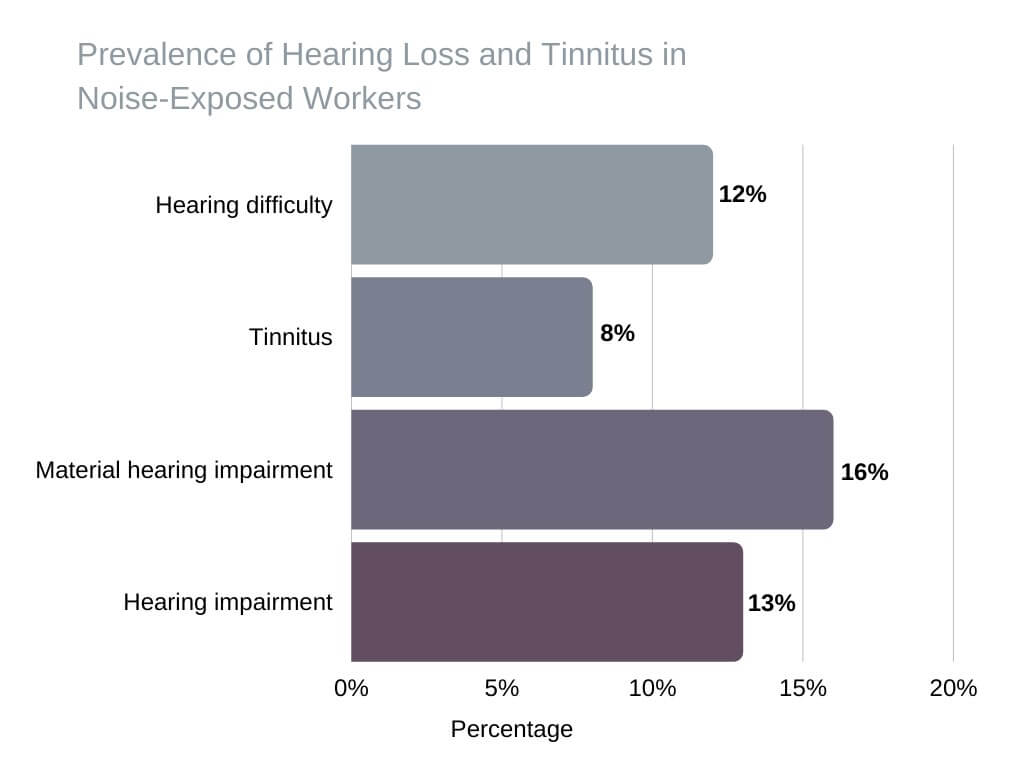
Conclusion
Suffering from hearing loss is already complicated enough without having to pull your hair out over which hearing aid is right for you. Thankfully, there is a device to suit every preference and need, and this article provides you with a comprehensive overview of the most popular options on the market.
If you’re looking for completely invisible hearing aids or comfortable BTE hearing aids with excellent sound quality, like those manufactured by MDHearingAid, you have myriads of options available to you.
For more information on the affordable, high-quality BTE hearing aids mentioned above, check out our complete MDHearingAid review.

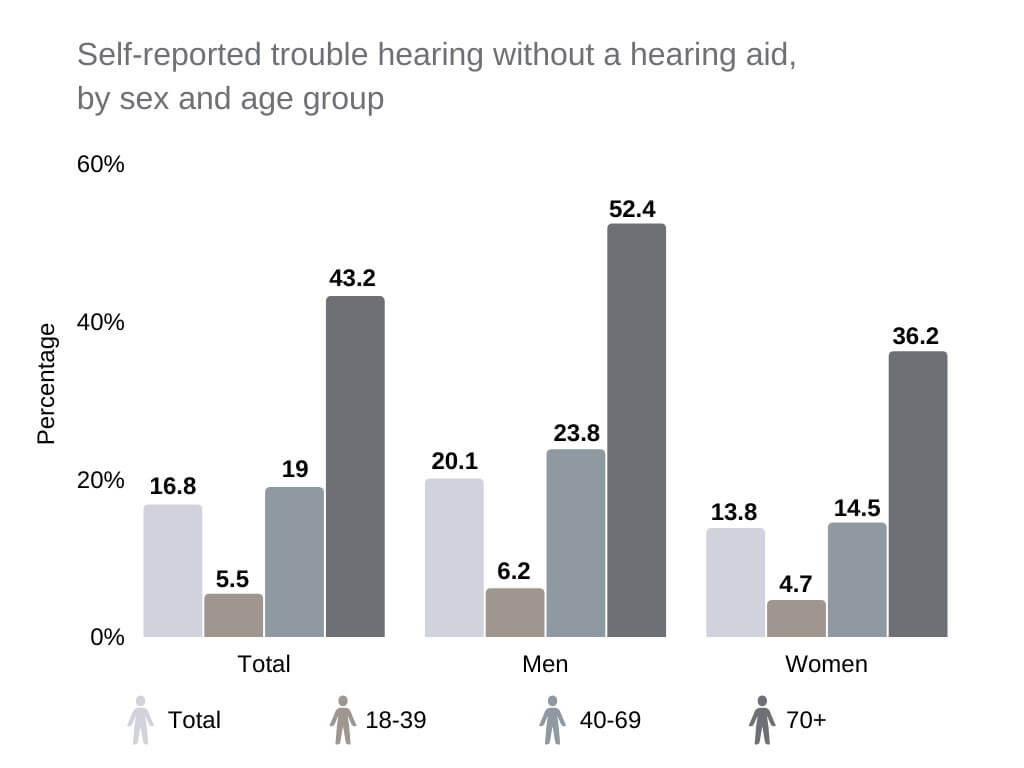
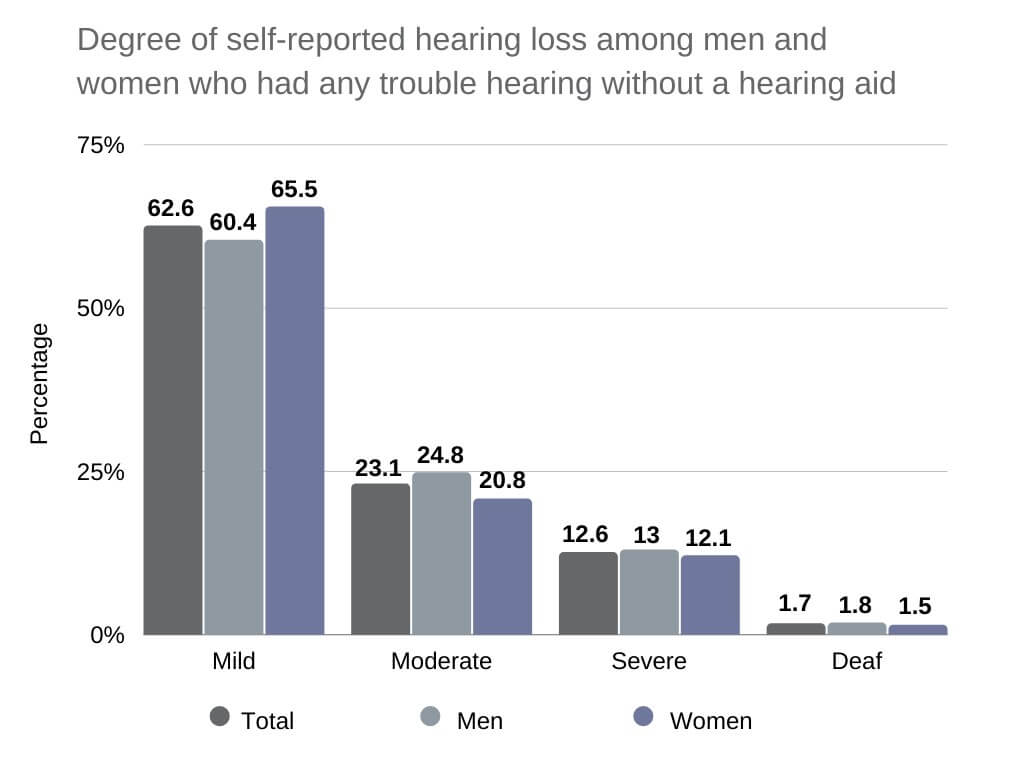




Leave a Reply